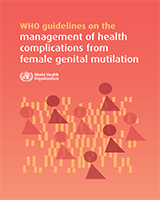The dissemination and implementation of these guidelines are crucial steps for improving the quality of health care and health outcomes for girls and women living with FGM. The WHO Department of Reproductive Health and Research has adopted a formal “Knowledge-to-Action” (KTA) framework for the dissemination, adaptation and implementation of guidelines.1 In addition to this KTA framework, the actions described in this section will further facilitate these processes.
4.1. Dissemination of the guidelines
The recommendations and best practice statements contained in these guidelines will be translated into Arabic and French and disseminated with the cooperation of a broad network of international partners, including: WHO country and regional offices; ministries of health; WHO collaborating centres; professional associations; other UN agencies, particularly the United Nations Population Fund (UNFPA) and the United Nations Children's Fund (UNICEF); and NGOs. They will also be available on the WHO website2 and in the WHO Reproductive Health Library (RHL).3 In addition, an executive summary aimed at clinicians and a wide range of policy-makers and programme managers will be developed and disseminated through WHO country offices and their respective partners, focusing particularly on countries with high prevalence of FGM.
A series of systematic reviews, which were the result of the scoping exercise carried out in preparation for the development of these guidelines, will be published in a peer-reviewed journal. Lastly, a package of practical tools – including a clinical handbook, job aids and training curricula for health-care providers, and health policy and health systems strengthening tools – will be developed based on the recommendations and best practice statements contained in these guidelines.
4.2. Implementation of the guidelines
The successful introduction into national programmes and health-care services of evidence-based policies related to interventions to improve health outcomes among girls and women living with FGM relies on well-planned and participatory, consensus-driven processes of adaptation and implementation. These may include the development of new national guidelines or adaptation of existing national guidelines or protocols using these WHO guidelines as a reference.
The recommendations and best practice statements contained in these guidelines should be adapted into locally appropriate documents that can meet the needs of each country and its health services, while taking the availability of human and financial resources into account; this should include national policy as well as local clinical guidance. In this context, modifications may be limited to conditional recommendations, and justification for any changes should be made in an explicit and transparent manner.
An important requisite for the implementation of the recommendations and best practice statements contained in this document is the creation of an enabling environment for their use (i.e. availability of medical supplies and a private area for talking with clients while providing psychological support), paired with adequate training of health-care practitioners and managers to enable the use of evidence-based practices. In this process, the role of local professional societies is also important, and an inclusive and participatory process should be encouraged.
4.3. Monitoring and evaluating the impact of the guidelines
Ideally, implementation of the recommendations and best practice statements contained in these guidelines should be monitored at a health-care facility level. Interrupted time-series of clinical audits or criterion-based clinical audits could be used to obtain data related to changes in the care that is given to girls and women who experience health complications from FGM. Clearly defined review criteria and monitoring and evaluation indicators are needed and could be associated with locally agreed targets. Final selection of indicators in each country context should consider measurability and feasibility. The following list includes several suggested indicators:
the number of countries establishing primary care guidelines on management of health complications from FGM, and changes in national and health-care guidelines in accordance with WHO guidelines;
the proportion of health-care providers trained:
to identify the different types of FGM
to know the prevalence and health risks of the procedure
to prevent and manage complications of FGM;
the proportion of health-care facilities that have carried out an institution-wide assessment of all policies, protocols and practices that impact girls and women living with FGM, including adequate referral pathways, human resources, training provided to health workers, and available written policies and protocols distributed to decrease medicalization of the practice and to prevent and manage complications among girls and women who have undergone FGM;
the proportion of women living with type III FGM who received deinfibulation before or during childbirth;
the proportion of women living with type III FGM who requested re-infibulation after being deinfibulated to facilitate childbirth;
the proportion of health-care providers who perform any form of FGM, including re-infibulation;
the proportion of women living with FGM who were provided with information about the health risks associated with the practice; and
the number of medical and allied health faculties that implemented undergraduate and postgraduate training on FGM, including identification of types of FGM, health risks associated with it, prevention and management of health complications from FGM, and the risks associated with the medicalization of the practice.
4.4. Updating the guidelines
These guidelines will be updated following the identification of new evidence that indicates a need to change one or more of the recommendations. Given that the evidence for all recommendations was either of low quality or non-existent, new recommendations or a change in the published recommendations may be warranted before the end of the usual five-year period. The WHO Steering Group will continue to follow the research developments in the field of FGM, particularly in the areas that were identified as research priorities during the retrieval and examination of evidence for these guidelines.
WHO welcomes suggestions regarding additional topics for inclusion in the updated guidelines. Please send your suggestions by email to:
tni.ohw@lave_gnirotinom_rhr

